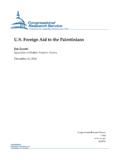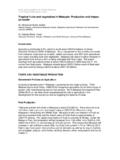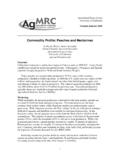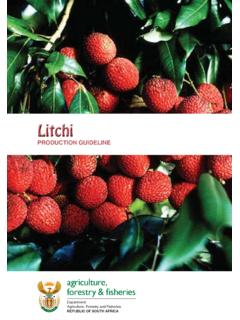Transcription of The U.S. Trade Situation for Fruit and Vegetable …
1 The Trade Situation for Fruit and Vegetable Products Ren e Johnson Specialist in Agricultural Policy December 1, 2016 Congressional Research Service 7-5700 RL34468 The Trade Situation for Fruit and Vegetable Products Congressional Research Service Summary Over the last decade, there has been a growing Trade deficit in fresh and processed fruits and vegetables. Although Fruit and Vegetable exports totaled $ billion in 2015, imports of fruits and vegetables were $ billion, resulting in a gap between imports and exports of $ billion (excludes nuts and processed nut products). This Trade deficit has generally widened over time as growth in imports has outpaced export growth.
2 As a result, the United States has gone from being a net exporter of fresh and processed fruits and vegetables in the early 1970s to being a net importer of fruits and vegetables today. A number of factors shaping current competitive market conditions worldwide, and global Trade in fruits and vegetables in particular, partially explain the rising Fruit and Vegetable Trade deficit. These include: a relatively open domestic import regime and lower average import tariffs in the United States, with products from most leading suppliers entering the duty-free or at preferential duty rates; increased competition from low-cost or government-subsidized production; continued non-tariff Trade barriers to exports in some countries, such as import and inspection requirements, technical product standards, and sanitary and phytosanitary (SPS) requirements.
3 Opportunities for counter-seasonal supplies, driven in part by increased domestic and year-round demand for fruits and vegetables; and other market factors, such as exchange rate fluctuations and structural changes in the food industry, as well as increased overseas investment and diversification in market sourcing by companies. In the buildup to the 2008 farm bill (Food, Conservation, and Energy Act of 2008, 110-246), the Trade Situation contributed to demands by the produce sector that Congress consider expanding support for domestic Fruit and Vegetable growers in farm bill legislation.
4 Historically, Fruit and Vegetable crops have not benefitted from the federal farm support programs traditionally included in the farm bill, compared to the long-standing support provided to the main program commodities (such as grains, oilseeds, cotton, sugar, and milk). The 2008 farm bill provided additional support for specialty crop programs, as well as organic programs. The farm bill also reauthorized two programs intended to address existing Trade barriers and marketing of specialty crops, including (1) USDA s Market Access Program (MAP) to promote domestic agricultural exports, including specialty crops and organic agriculture; and (2) Technical Assistance for Specialty Crops (TASC) to address sanitary and phytosanitary (SPS) and technical barriers to exports.
5 The 2014 farm bill (Agricultural Act of 2014, 113-79) reauthorized and expanded many of the provisions benefitting specialty crop growers. The Trade Situation for Fruit and Vegetable Products Congressional Research Service Contents Fruit and Vegetable Trade Situation .. 2 Summary .. 2 product 3 Importing Country Overview .. 3 Competitive Market Situation .. 5 Domestic Import Regime .. 5 Global Competition .. 7 Non-Tariff Trade Barriers .. 9 Seasonal Supplies .. 12 Other Market Factors .. 13 Congressional Action .. 15 Figures Figure 1. Fruit and Vegetable Trade (Excluding Nuts), 1990-2015 .. 1 Tables Table 1.
6 Value of Fruit and Vegetable Trade , 1990-2015 .. 2 Table 2. Country Suppliers of Fruit and Vegetable Imports .. 4 Table 3. Import Share of Fresh Fruit and Vegetable Demand .. 13 Contacts Author Contact Information .. 16 The Trade Situation for Fruit and Vegetable Products Congressional Research Service 1 ver the last decade there has been a growing Trade deficit in fresh and processed fruits and vegetables. Although Fruit and Vegetable exports totaled more than $6 billion in 2015, imports were nearly $18 billion, resulting in a gap between imports and exports of more than $11 billion for the year (Figure 1).
7 This Trade deficit has widened over time, as growth in imports has outpaced export growth. As a result, the United States has gone from being a net exporter of fruits and vegetables in the 1970s to having a net Trade balance in the mid-1990s to being a net importer today. Figure 1. Fruit and Vegetable Trade (Excluding Nuts), 1990-2015 Source: Compiled by CRS from data in the International Trade Commission s Trade DataWeb database (version ). Includes fresh and processed products; excludes nuts. A number of factors are shaping current competitive market conditions worldwide and global Trade in fruits and vegetables.
8 In the buildup to the 2008 farm bill (Food, Conservation, and Energy Act of 2008, 110-246), the Trade Situation contributed to demands by the produce sector that Congress consider expanding support for domestic Fruit and Vegetable growers in farm bill legislation. Historically, specialty crops1 had not benefitted from the federal farm support programs traditionally included in the farm bill, compared to the long-standing support provided to the main program commodities (such as grains, oilseeds, cotton, sugar, and milk). The 2008 farm bill, and later the 2014 farm bill (Agricultural Act of 2014, 113-79), provided additional support for programs supporting Fruit and Vegetable production, as well as programs addressing existing Trade barriers and marketing of specialty crops.
9 This report presents recent trends in Fruit and Vegetable Trade , and highlights some of the factors contributing to these trends. This summary excludes Trade data for tree nuts and processed tree nut products. Although not presented here, exports and imports of tree nuts and processed tree nut products (excluding peanuts) have shown continued increases and, generally, a growing Trade surplus. 1 Specialty crops include fruits and vegetables, tree nuts (not including peanuts), dried fruits, nursery crops, and floriculture, as defined by the Specialty Crops Competitiveness Act of 2004 ( 108-465).
10 O The Trade Situation for Fruit and Vegetable Products Congressional Research Service 2 Fruit and Vegetable Trade Situation Summary The Trade deficit in fresh and processed fruits and vegetables totaled more than $11 billion in 2015, following a decade of steady gains in imports, with more variable gains in exports (Table 1, Figure 1). In the early 1990s, imports and exports of fresh and processed fruits and vegetables were more or less in balance, with some years showing the United States as a net exporter. This Situation reversed in the mid-1990s. Despite rising exports of fruits and vegetables, growth in imports has outpaced export growth.















